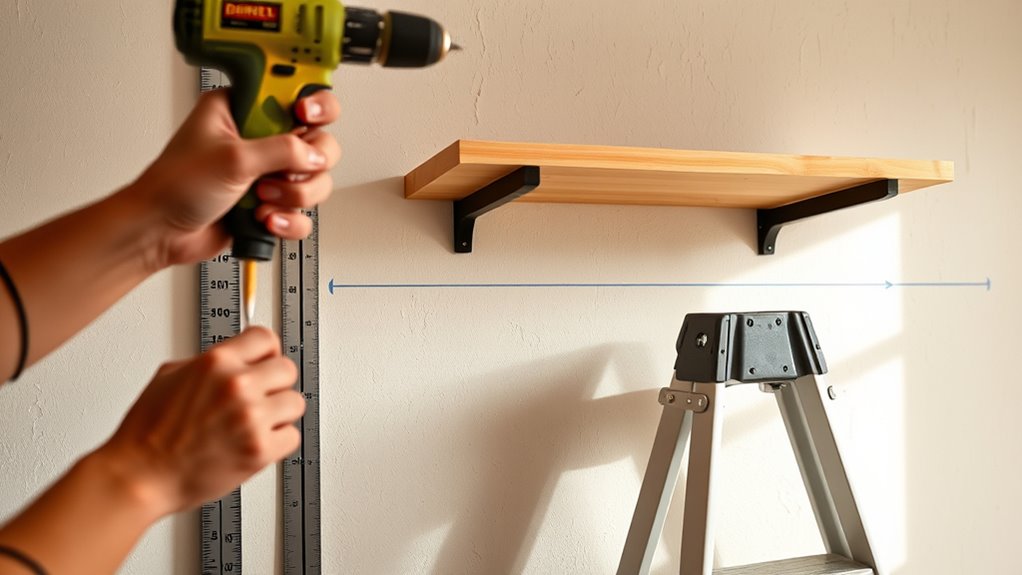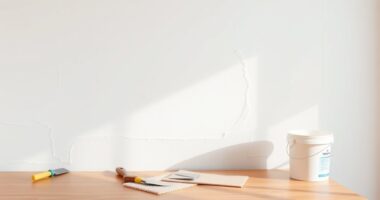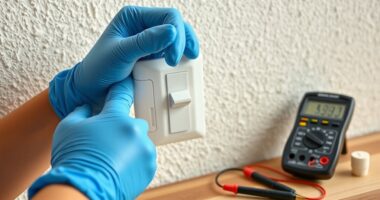To hang shelves on drywall, first select the right anchors based on the weight you plan to support, like plastic expansion or toggle bolts. Mark the wall carefully with a level, drill holes that match your anchors, then insert the anchors securely. Attach the shelf brackets with appropriate screws, tighten until firm, and check for stability. For detailed tips on choosing anchors and ensuring safety, continue exploring the best techniques for a secure and long-lasting shelf.
Key Takeaways
- Select appropriate drywall anchors based on the shelf’s weight and wall condition.
- Mark the desired shelf height and drill holes matching the anchors’ size.
- Insert anchors securely into the drywall, ensuring they sit flush.
- Attach the shelf brackets or mounting hardware using compatible screws and anchors.
- Check stability, re-tighten if needed, and avoid exceeding weight limits for safety.

Hanging shelves on drywall is a straightforward task that can enhance your space without causing damage. To do this effectively, you need to understand the types of drywall anchors available and how they relate to the shelf’s weight capacity. Choosing the right anchors ensures your shelf stays secure and prevents accidents or damage to your wall.
There are several types of drywall anchors to consider, each suited for different weights and wall conditions. Plastic expansion anchors are common for light loads, as they expand behind the drywall when you screw into them, providing a decent grip. Metal anchors, such as toggle bolts or molly bolts, are better for heavier items because they distribute weight more evenly and hold more securely. If you’re hanging a shelf that will carry a significant load, opting for toggle bolts or heavy-duty anchors is your best bet.
Before you begin, it’s essential to determine the shelf weight capacity—how much weight it can safely support. Most shelves specify a maximum load, and exceeding this can lead to damage or failure. Measure your items and add a safety margin to ensure the shelf remains secure over time. Once you know the weight capacity, select the appropriate drywall anchors that can support that weight. Using anchors not rated for your shelf’s weight can cause the shelf to pull out or damage the drywall.
To start, mark where you want your shelf to go. Use a level to make sure your marks are straight—this prevents a crooked shelf. After marking, drill holes at the spots you’ve marked, making sure to choose drill bit sizes that match your drywall anchors. Insert the anchors into the holes; for plastic expansion anchors, push them in until flush. For toggle or molly bolts, you’ll need to thread them through the mounting holes first, then secure them behind the drywall as you tighten.
Once your anchors are in place, align the shelf brackets with the holes. Use screws appropriate for your anchors—usually provided with the anchors or specified in the instructions. Tighten the screws firmly, but avoid overtightening, which can crack the drywall or strip the anchor. Check that your shelf feels sturdy and doesn’t wobble. If it does, re-tighten or consider adding additional anchors for extra support. Additionally, understanding the role of drywall anchors is crucial in ensuring your shelf remains secure over time.
Frequently Asked Questions
What Tools Are Necessary for Hanging Drywall Shelves?
To hang drywall shelves, you need essential tools like a drill, screwdriver, level, and measuring tape. Choose sturdy shelf materials suited to your needs. Before installing, prepare your wall by cleaning and marking where the shelves will go. Using the level guarantees your shelves are straight, and the drill helps you securely attach brackets or anchors. Proper wall preparation and the right tools make hanging shelves easier and more stable.
How Do I Choose the Right Anchors for Different Shelf Weights?
You might think any anchor works for all shelves, but research shows anchor types are vital based on weight considerations. Light loads, like picture frames, need simple plastic anchors, while heavier shelves require more robust options like toggle bolts or molly bolts. Always assess the weight of your shelf and items, then choose anchors designed for that load. Proper anchor selection ensures stability and prevents damage or accidents.
Can I Hang Shelves on Textured or Wallpapered Drywall?
You can hang shelves on textured drywall or wallpapered surfaces, but it’s trickier. For textured drywall, use longer, sturdy anchors and avoid sanding or removing texture. If wallpaper is present, consider removing it for a smoother surface or use specialized adhesive hooks. Before hanging, remove wallpaper and smooth out textured areas to make certain the anchors hold securely, preventing damage and ensuring your shelves stay safely in place.
How Do I Ensure the Shelves Are Level and Evenly Spaced?
To guarantee your shelves are level and evenly spaced, start with measuring techniques like using a tape measure and a level. Mark your spots carefully, following spacing guidelines that suit your room’s proportions. Double-check your measurements before drilling, and use a level to verify alignment as you go. This approach guarantees your shelves will be perfectly level and uniformly spaced, giving your space a polished, professional look.
What Safety Precautions Should I Take During Installation?
Ever wonder if hanging shelves comes with a hidden danger? Well, it does—so suit up with safety gear like goggles and gloves to dodge unexpected debris, and remember electrical safety if you’re near outlets or wiring. Keep your workspace clear, use the right tools, and stay focused. After all, a safe hang is a happy shelf, and nobody wants a drywall disaster to be their claim to fame.
Conclusion
Hanging shelves on drywall is simple once you know the right techniques. Remember, using proper anchors and measuring carefully guarantees your shelves stay secure and level. Did you know that adding just three shelves can increase your storage space by up to 30%? So, with a few tools and some patience, you can maximize your wall space efficiently. Get started today and enjoy a more organized and functional room in no time!









